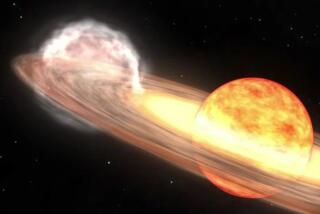They call it the superstar of supernovas
- Share via
Shining like a hay fire across a wide prairie, the brightest supernova ever recorded has been found in a galaxy 240 million light-years from Earth.
Astronomers said Monday that the supernova might represent a new way for giant stars to die.
“Of all the exploding stars ever observed, this was the king,” said UC Berkeley astronomer Alex Filippenko. “We were astonished to see how bright it got, and how long it lasted.”
Six months after it was spotted by University of Texas graduate student Robert Quimby, it is still as bright as an average supernova, NASA astrophysicist Alan Smale said at a news conference in Washington.
Astronomers identified the star as SN 2006gy. They estimated its size at more than 100 solar masses, which makes it one of the largest stars ever observed. The Milky Way, with a population of 400 billion stars, has only a few known to be as big.
The supernova’s power is so immense that it outshines its galaxy, NGC 1260, home to some of the oldest known stars in the cosmos, scientists said. It was observed by the Chandra X-Ray Observatory in space, as well as by telescopes on Earth.
Stars 10 times the size of Earth’s sun and larger had been thought to end their lives by burning off the heavier elements until the fusion process that powers the stars stopped.
At that point, the heat produced in the core of the star can no longer support itself and the star starts to collapse.
The outer shell is blown off in a typical supernova, of which hundreds are seen every year across the cosmos, while the inner layers go on crunching until the star becomes a highly compact neutron star or a black hole.
In the case of SN 2006gy, it appears the core didn’t collapse. It exploded, setting off a cascade of events that tore the star apart, leaving nothing but stellar debris.
“This discovery forces us to go back to the drawing board to understand how the most massive stars die,” said UC Berkeley astronomer Nathan Smith. “Instead of just winking away into a black hole, they apparently can suffer these brilliant explosions that can be seen far across the universe.”
Scientists said the supernova in NGC 1260 might hold the key to the fate of Eta Carinae, a giant star in the Milky Way.
Before it exploded, SN 2006gy expelled a large amount of its mass. Eta Carinae, the largest known star in Earth’s galaxy, did the same thing in 1843, in what astronomers called a supernova impostor event.
If Eta Carinae were to go supernova the way SN 2006gy did, it would release so much energy that it could be seen on Earth in the daytime, even though it is 7,500 light-years away. It would be about a tenth as bright as a full moon, scientists said.
“We don’t know for sure if Eta Carinae will explode soon, but we had better keep an eye on it just in case,” said Mario Livio of the Space Telescope Science Institute in Baltimore, who was on the panel that presented the findings.
“Eta Carinae’s explosion could be the best star show in the history of modern civilization,” he said.
Astronomers said they didn’t fully understand the explosion that obliterated SN 2006gy. But they think such self-annihilating events may be the way the earliest stars in the universe met their deaths.
The early universe is thought to have been dominated by giant stars made up of fairly simple chemistry that blew themselves out after a few million years. When they did, they seeded the cosmos with the heavy elements needed to build planets and, eventually, life.
The pioneer suns of the early cosmos 14 billion years ago were replaced by smaller but more complex stars -- like our sun -- that typically live billions of years.






